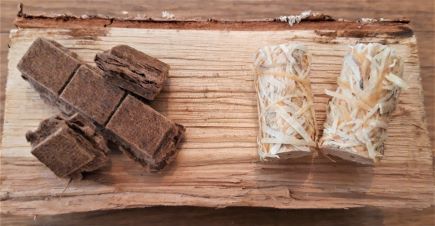There is an abundance of products on the natural eco firelighter market nowadays. The main two options are firelighter cubes and wood wool firelighters. We would like to have a closer look at these two eco-friendly products and compare how they affect the environment.
What are Eco Firelighter Cubes made of?
Firelighter cubes are made from compressed sawdust and vegetable oil. That’s it, just two ingredients, no additives! The sawdust is a bi-product of wood manufacturing, like production of building timber, pallets, furniture and firewood. So, instead of being thrown away, the sawdust is turned into something useful and beneficial for both the wood manufacturer and the end consumer.
No paraffin or palm oil is used in firelighter production, therefore they are non-toxic, and consequently it is safe to store the cubes beside your food. Also, the use of vegetable oil means that when the firelighters are lit they do not give off the horrible petrol smell unlike the traditional petroleum-based firelighters. And this makes them ideal for cooking the food.
What are Wood Wool Firelighters made of?
Wood wool firelighters are made from the same products as the cube firelighters, but the manufacturing process is slightly different. Wood wool is a light, bio-degradable void fill made from shredded timber.
Lots of people have probably seen wood wool either in a hamper at Christmas or in a supermarket packed in a cheese and wine set. When used in packaging it is definitely 100% better than using polythene, polystyrene and plastic products. However, wood wool firelighters are made from compacted material, meaning there is a much greater amount of raw material required to produce those firelighters. Wood wool comes from shredding trees, which primary purpose is not to be used as a piece of furniture or building material, but rather a fire lighting aid.
Which one is better?
Similarly, both firelighters are made from natural products and are biodegradable. They are CO2 neutral and are safe to ignite, as they don’t flare up.
Burn from 8 to 20 minutes and do not dry out or lose their firepower, even after box opening. There is no unpleasant smell and they are not oily or greasy.
There are no petroleum products used in the production of both firelighters. No kerosene, paraffin wax, no formaldehyde nor added chemicals which makes them non-harmful if in contact with vegetation, plants and aquatic organisms.
Finally, if we are talking about price, then they are very similar.
So, which one to choose? You can weigh up all the pros and cons and decide for yourself based on your personal preferences.
For best natural eco-friendly firelighters go to: woodabrix.co.uk

